Text and photos by Steven Nestor.
In the summer of 1996 I was lying in a Parisian park listening to an article being read aloud on the events surrounding the disaster that had befallen climbers on Everest the previous May. Although I’d never been overly fascinated with mountains or mountain life, the story left quite an impression on me. Despite the most modern of communications, equipment and planning, nature had intervened at a time of her choosing to take eight climbers. Further increasing my new found interest in mountains, and in particular the cold, I later read Jon Krakauer’s (controversial) Into Thin Air. There followed readings of other stories like Touching the Void or the epic tale of Toni Kurz’s last climb. In my mind’s eye I began to better envisage our insignificance and fragility when pitted against a collusion of mountains and nature aiming to eradicate our daring incursions.
I’m not sure whether it’s because of these extreme stories, but whenever I was skiing I preferred overcast or snowy days that hinted at something greater beyond the order of colour-coded slopes under a serene blue sky. Despite a hyper rationalized world, there must still be some residual memory of eons ago when life was dictated to by unkind winters, dragons and God. Although today you can get back into your house or car, the elements pushing against you are the same that wore Ötzi down once-upon-a-time ago. And the snow in the picturesque skiing village that you brush against on a sub-zero night when your breath is turned to crystals is the same that numbs the life out of the lost climber. It’s the same that stopped Napoleon and Hitler.
Lying on the valley floor at 1,800m the small French alpine town of Bonneval-sur-Arc is effectively the end of the road as the next hamlet is cut off and abandoned over the winter months. In late December of 2011 I was back for a week’s stay. For much of the time we were there heavy snowfalls and wind dominated, closing slopes and leaving us unsure as to whether we would be able to leave the valley on time. The locals said it was some of the worst weather they had experienced in 20 years. In Europe’s east dozens succumbed as a deep arctic chill expanded westward.
In a time with claims that the earth is warming at such a pace that entire mountain ranges will be snow free within our lifetime, I for one found being enveloped in a snowstorm to be comforting. Somehow all seemed well again in this incomprehensible and perpetually lost world. The winter before, Ireland and Britain had been gripped by uncharacteristically cold weather and, care of the “end is nigh” media, I had heard for the first time talk about the Maunder Minimum of prolonged freezing winters in Europe. Most notable was the so-called Great Frost of 1683–84 when the river Thames froze for weeks with ice recorded as being nearly 30cm thick. Now with the unexpected presence of an unusually and unexpectedly cold winter some experts were speculating as to the possibilities of its return.
In the midst of a harsh alpine winter, I had time to reflect on representations of winter in art and in particular, two painters. There was the acute memory of Bruegel’s Hunters in the Snow, so much easier to recall in the white cold than googling it online or standing before it in a climate-controlled museum. I was beginning to understand this painting as a “report” or message beyond a superficial admiration of the painter’s technique: this is winter, this is what it does to our world.
The other painter to occupy my thoughts was the far lesser known – though equally impressive – Tino Aime with his depictions of northern Piedmont in deep overcast winters in a waning light and void of colour, except for the odd bright berry. While he has painted in modern times his work perfectly illustrates that still emptiness of the outwardly lifeless mountain village in the dead of winter. Nowadays, however, many of those villages have been abandoned and, steadily roofless, blend into the mountains’ rocks, forests and snow. Life had been too tough. Others are only for the fair weather visitors or have been transformed for the skiing season.
Returning to Bonneval-sur-Arc for a second time meant being surer of what photographic treatment and approach the valley could be given. I didn’t want to try to work on or extract what little colour was in evidence or focus on the postcard village. Rather, I wanted to shoot on black and white transparency to best record the subtleties of tone in what is largely a monochromatic landscape mostly devoid of human presence. I was determined to immerse myself for as extended a time as was possible in this alien landscape, from the morning to after sundown when few, if anyone, was still out beyond the village, and surely no one else with a camera.
Even though modern transportation and infrastructure desensitizes the traveller, time spend in the Alps in winter cannot fail to impress. Beyond the roads, paths and slopes lies an inhospitable and impassable beauty evident to even the most uninterested traveller. Snow changes everything. Walking is laboured and subtler features obscured. Sounds are muffled and the flat light wipes away all texture, compressing surfaces to the flatness of a clean page. I pass the Risques d’avalanches sign on a snowshoe track no wider than my shoulders. Leave it and you’re knee or thigh deep in snow. There may be no more dragons or desire for a god in many, but I strangely feel that I somehow shouldn’t be there recreationally. It’s unnatural and what is understood as beauty by me and the multitudes of other urbanites has been termed ‘White Death’ by others. Hannibal’s sure dreams of taking Rome vanished along with 18,000 of his men in these mountains. I should never have been able to reach this valley with such ease. At most I ought to be cloistered in one of Aime’s dormant villages longing for the spring and the opening of meadows and passes. I’m riding some freak spike in world history that allows people go wherever they choose. I’m on the top of Babel. And I have equally become aware of nature’s ambivalence towards the sole walker. ‘And Petit-Jean said to me — “You see that [snow]? Do you see it? Well, it doesn’t see you!”’
Of course I cannot claim that I took these photographs solely because of painters and talk of cold cycles. But, in this altered environment I felt I could come closer to the vision transmitted by these artists and the possibility of a new Great Frost. It was in this frame of mind that I sought to engage with the same essential physical elements presented to and by the likes of Bruegel and Aime, and to capture the malign muteness and vastness of a pronounced winter in the mountains in an epoch of severance from that which thwarted our ancestors.
When walking alone in the snow towards the valley’s end it becomes clearer how the immediacy of all things Internet and a fully mapped world can lead us in our predominantly urban lives to forget what our scale once meant and the utter indifference of nature. Once upon a time the snows isolated communities for months on end. Ötzi was held for three millennia before being given up, but now it’s only a three hour drive from Turin, or 45mm away on a 1:1 200 000 map. And I can’t pretend that I’m blind to the diverting beauty of this place, or that I don’t enjoy it on the same level as those I’m with.
Then I remembered the booms during the snowstorm at night. High up the mountains they were detonating bombs to curb the risk of avalanche. So even at the most inaccessible heights we can exercise control remotely. I’m forced to reconsider my work and my dwelling on the old significance of winter in the mountains. It’s January 1st 2012 and I’ve photographed the descente aux flambeaux. They’re serving free hot chocolate and vin brulé. Editing my work I reassess the merits of an earlier colour image from the valley: the framing reminiscent of Aime’s landscapes. It’s pretty. I like it. And although I had been very pleased with the black and white approach, now I’m not so sure there’s much truth in my images beyond a pure analogue recording. They’re half the story, if. They’re what I wanted and got – few surprises – but I am increasingly aware that my careful, deliberate framing has conjured up a false reading of this place. Despite Godard’s seemingly infallible declaration in Le Petit Soldat that “la photographie c’est la vérité. Et le cinéma c’est vingt-quatre fois la vérité par seconde” – photography is the truth and cinema, 24 times the truth per second – as a practitioner it’s so obviously not. In my view finding in Bonneval-sur-Arc I conjured up a deceit. The snow and mountains are still the same that took the lost wanderer, but that’s all but irrelevant today.
And now it’s late December 2012 and I’m in Gressoney-La-Trinité: one day’s skiing in the falling snow. I can’t see a thing because my visor and glasses keep fogging. I don’t like skiing anymore, and the mountains in winter a little less. The next day the slopes are mercifully closed due to high winds.
Snow tyres and chains. In 30 minutes or so we’ll be clear of all the pretty suggestive snow and onto the dry drab plane below. Home in an hour and a half.
We always complain about the motorway tolls.
It is the end of winter.
For more stories and photos, please visit Steven Nestor website.

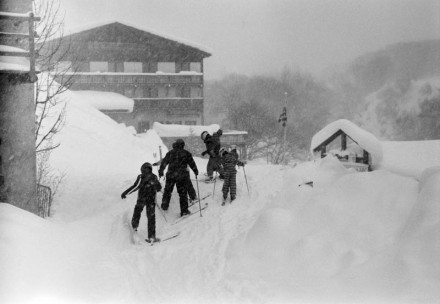
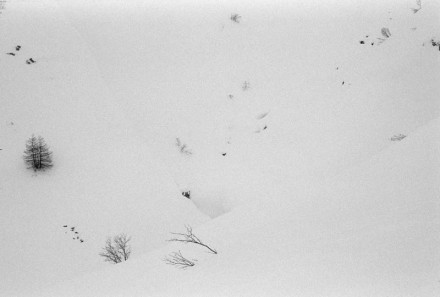
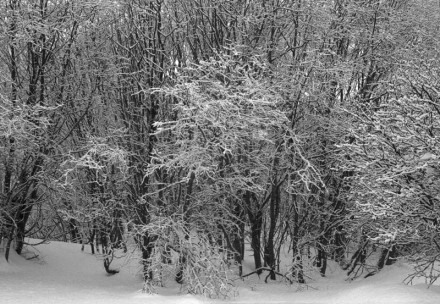
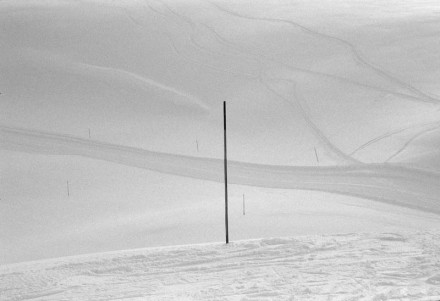
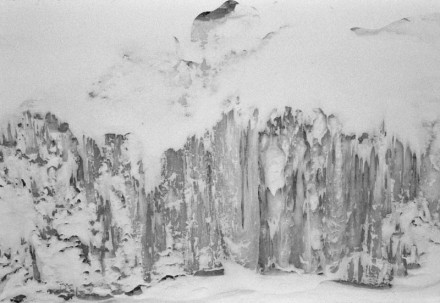
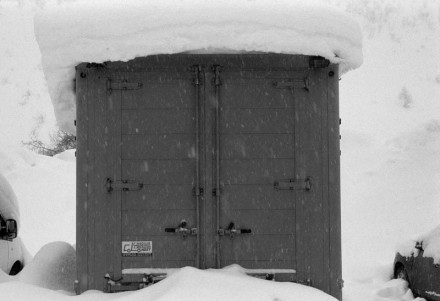
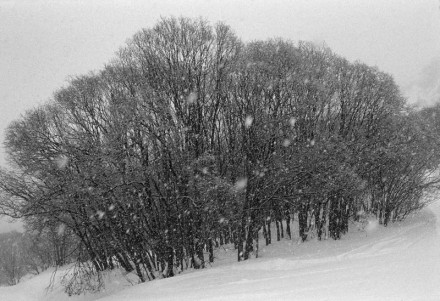
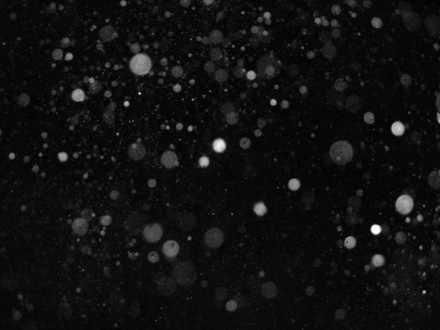
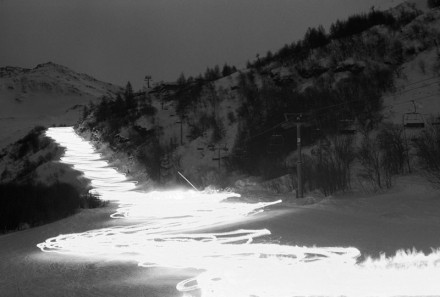
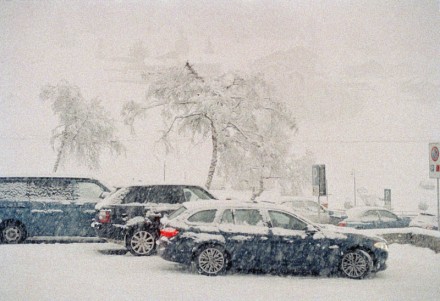
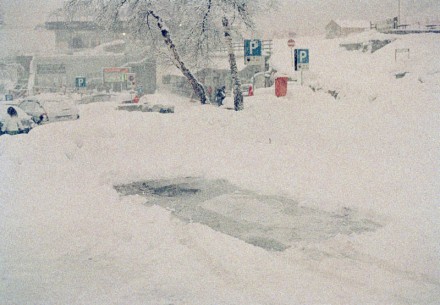
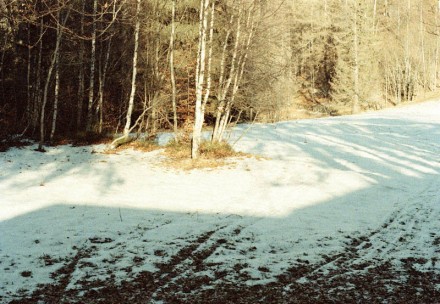
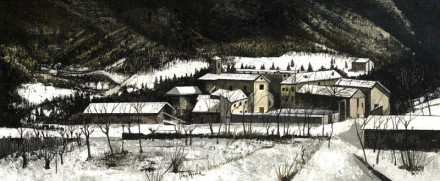
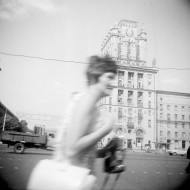
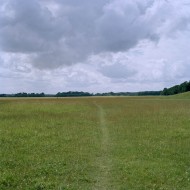
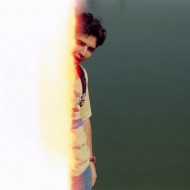

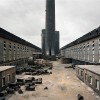





























You can also subscribe to this post comments RSS feed.